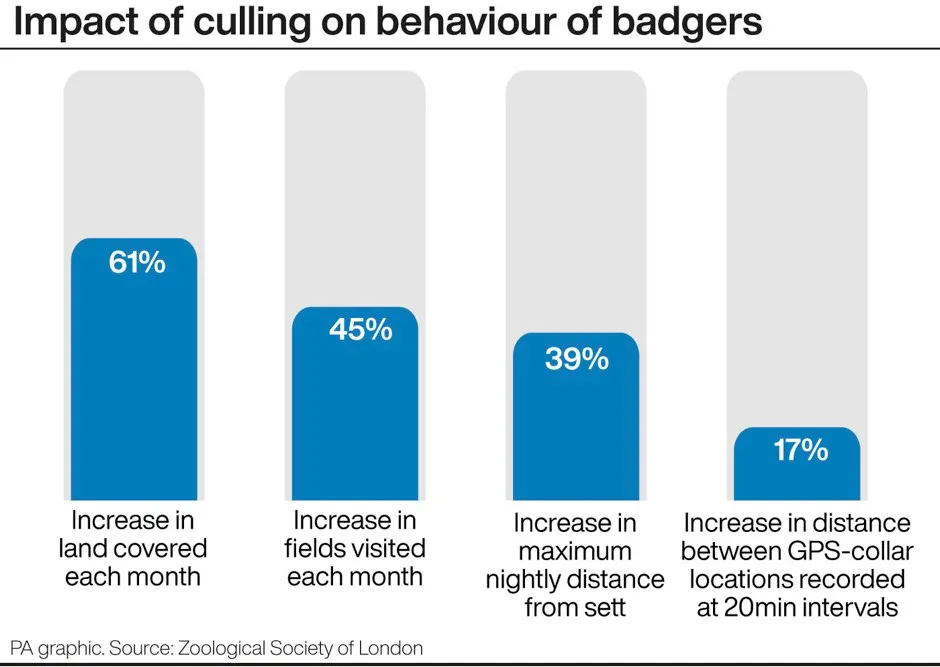The badger cull, intended to reduce the chances of the animals spreading bovine tuberculosis, may be having the opposite effect, according to newly published research. Carried out jointly by Imperial College London and the Zoological Society of London (ZSL), the research shows that surviving badgers roam across a much wider area after a cull, potentially increasing the transmission of bovine TB.
“As badger-to-cattle transmission is likely to occur through contamination of their shared environment, and TB bacteria can remain viable for long periods of time, the effects of increases in ranging behaviour could create a source of infection for several months – long after the individual badger has been culled,” says Prof Rosie Woodroffe, senior research fellow at the ZSL.
“In contrast, studies have shown that vaccination prompts no changes in badgers’ ranging behaviour.”
The researchers studied 67 badgers across 20 cattle farms in areas with and without farmer-led culling in Cornwall, collecting GPS-collar data between 2013 and 2017. Their study reveals that a cull drives badgers to cover 61 per cent more land each month than they did before.
Badgers were also found to visit 45 per cent more fields each month, and the odds of a badger visiting neighbouring territories each night increased 20-fold – potentially increasing the risk of TB transmission to both cattle and other badgers.
The researchers think that the culls remove certain badgers from established territories, opening them up to those that survive.
Read more about British wildlife:
- Whales and dolphins: Why are more of them beaching around the UK?
- How far can migrating birds fly non-stop?
- Weird science: six unusual studies on our favourite livestock
Interestingly, the badgers that survive a cull spend on average 91 minutes less per night outside their sett. ZSL scientists believe this could be linked to reduced competition and increased food availability, as rival badgers are removed from the population.
“Badgers spend a large proportion of the night foraging for food above ground, and as culling reduces the size of the population, competition for food will also be reduced," points out Cally Ham, of Imperial College London, the study’s lead author.
“We believe this accounts for the reduced activity levels, as well as bold individuals becoming obvious targets for culling and being quickly removed from the population.
“Because culling partly relies on shooting badgers moving around at night, the fact that badgers were active for fewer hours per night could actually be undermining culling efforts to further control badger numbers.”

Last year the Government commissioned a review of its strategy for tackling bovine tuberculosis (bTB) in livestock amid ongoing controversy about badger culling to control the disease.
Measures to tackle the disease include cattle testing and movement controls, improving “biosecurity” or protective measures to prevent disease spread on farms, developing vaccines for cattle and badgers and culling badgers – which can spread TB to cattle – in 32 areas of England.
The independent review found farmers must do more to tackle the spread of tuberculosis between cattle, which is a bigger part of the problem than badgers.
While it said that culling showed a “real but modest effect” and was a judgment call for ministers, the review led by Sir Charles Godfray said poor take up of biosecurity measures and trading in high-risk livestock was hampering disease control.

Since the UK Government implemented the culling policy in 2011, ZSL scientists have been working to understand whether badger vaccination could be used to reduce the infection of TB in the UK’s badger population, and so help control TB in cattle.
A spokesman for the Badger Trust said: “The latest research from ZSL shows that this mass destruction of a protected species could be resulting in perturbation, increasing the risk of TB spread in badgers and possibly cattle.”
He added: “Badger vaccination is the most cost-effective and humane way of reducing TB in badgers, that do not have the disease.
“It also removes the risk of perturbation and brings farmers and wildlife protection groups together in a spirit of mutual respect, trust and confidence.
“The Government should halt the culling of badgers and move to a national badger vaccination strategy.”
A Defra spokesman said: “Bovine TB remains the greatest animal health threat to the UK, costing taxpayers over £100 million every year as well as causing devastation and distress for farmers and rural communities.
“There is no single measure that will provide an easy answer to beating the disease and we are pursuing a range of interventions to eradicate it by 2038, including tighter cattle movement controls, regular testing and vaccinations.”